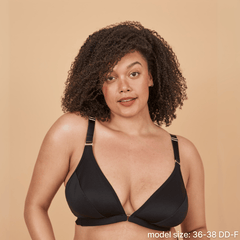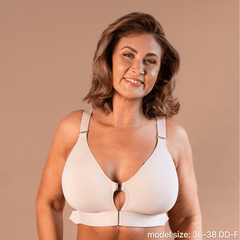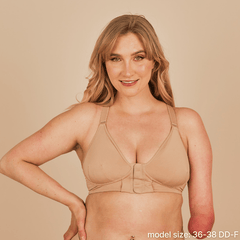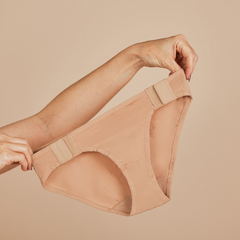Bras come in an astonishing array of styles, designs, and functions, catering to various body types, fashion preferences, and practical needs. The diversity in bra types is truly remarkable, offering options for support, comfort, style, and functionality.
Bras 101

Bras are more than just undergarments; they're an essential part of a woman's wardrobe, providing support, comfort, and confidence.
At their core, bras are designed to offer support to the breasts, reducing strain on the back and shoulders by distributing the weight. The fundamental components of a bra include the cups, which encapsulate and support the breasts, and the band, which wraps around the ribcage, providing stability and anchoring the bra in place. Straps play a crucial role, offering additional support and adjustability.
Understanding the importance of proper sizing is paramount—finding the right band and cup size ensures both comfort and efficacy. A well-fitted bra not only feels better but also enhances posture and silhouette.
The world of bras is incredibly diverse, accommodating various body types, preferences, and occasions.
From the everyday reliability of T-shirt bras to lingerie, each style serves a distinct purpose. Factors like materials, padding, wiring, and closure types contribute to the functionality and aesthetics of bras.
Whether it's the freedom of a wireless bralette or the structured support of an adaptive bra, choosing the right type can significantly impact comfort and confidence. Ultimately, bras go beyond mere clothing—they empower individuals by providing comfort, style, and the assurance of support throughout the day.
A Quick History on Bras

The evolution of bras traces back centuries, reflecting the changing ideals of beauty, fashion, and functionality. Early versions of breast support can be found in ancient civilizations, where women used bands, strips of fabric, or corset-like garments to provide some form of breast control and support.
However, it wasn't until the late 19th and early 20th centuries that the modern bra, as we recognize it today, began to take shape.
In the early 1900s, the corset, a restrictive undergarment popular in the Victorian era, started to lose favor as women sought more freedom and comfort. This led to the emergence of bras that focused on bust support and shaping without the rigidity of the corset.
The turn of the 20th century saw transformative innovations, notably the patenting of the "brassiere" by Mary Phelps Jacob in 1914. Her design featured two handkerchiefs held together by ribbon straps, creating a more flexible and comfortable alternative to the corset.
Subsequent decades witnessed significant advancements in bra design, including the introduction of cup sizes by the 1930s and the use of elastic materials for better fit and support. Throughout the 20th century, bras evolved in tandem with societal changes, embracing various styles like the bullet bra of the 1940s, the push-up bras of the 1950s, and the sports bras that gained popularity in the 1970s as women became more active.
Today, bras continue to evolve, incorporating new materials, technology, and designs to meet the diverse needs and preferences of women worldwide. For example, the development of adaptive bras is a recent innovation.
Adaptive Bras Versus Traditional Bras

Adaptive bras represent an innovative approach to bras, designed specifically for people with limited mobility as a result of aging, injuries, illnesses, or disabilities.
These bras prioritize functionality and ease of use, often featuring adaptive elements such as front closures, hook-and-loop fastenings (i.e. Velcro), and other easy-on features for easier dressing and undressing.
The construction of adaptive bras considers factors like limited mobility, dexterity challenges, or post-surgery requirements, ensuring that people can get dressed comfortably and independently. Often, they also reduce pain and make everyday a bit easier.
Additionally, adaptive bras may incorporate softer fabrics, seamless designs, and adjustable features to accommodate sensitivities or specific medical considerations, offering both support and comfort tailored to people’s needs. They are a subcategory of bra, since there is no restriction on the shape or type as long as it’s functional.
Historically, adaptive bras have been generally “medical-looking” with little focus on the design or aesthetic. Luckily, new brands such as Springrose are investing in developing adaptive bras that are both functional and fashionable. That way, no one has to compromise.
In contrast, traditional bras encompass a wide range of styles and designs focused primarily on support, shaping, and fashion.
While traditional bras come in various forms to suit different body types and preferences, they may lack the adaptive features that make it easier for people with limited mobility to put on the bra.
Traditional bras prioritize aesthetics and versatility, offering an extensive array of options from push-up to minimizer bras, with varying materials, patterns, and embellishments to align with fashion trends and personal styles.
Difference Between Bras and Bralettes

The distinction between bras and bralettes lies in their construction, support level, and intended use.
Bras, traditionally designed with structured cups, underwires, and adjustable straps, prioritize support and shaping. They come in various styles, offering specific functionalities such as push-up, sports, or adaptive bras.
Typically, bras cater to different activities, providing tailored looks and support for everyday wear, formal occasions, or athletic pursuits. The emphasis on support often involves firmer materials and strategic shaping elements to lift, separate, and define the bust, ensuring a specific level of stability and comfort.
On the other hand, bralettes are softer, often wire-free, and more relaxed in structure compared to bras. They prioritize comfort and style over intense support, featuring stretchy fabrics, lace, or decorative elements.
Bralettes usually lack the structured cups and underwires found in bras, offering a more natural shape and feel. They're versatile, often worn as standalone pieces or as part of layered outfits, showcasing a trendier, more casual aesthetic.
Given the light support, bralettes are not intended for high-impact activities or for those seeking extensive support. Instead, they provide a comfortable option for those looking for minimal shaping and a more relaxed fit.
Bra Shapes
- T-Shirt Bra

Seamless and molded cups, perfect for everyday wear under fitted tops.
- Push-Up Bra
Designed to lift and enhance cleavage, providing a fuller look.
- Sports Bra
Offers maximum support and minimizes breast movement during physical activities.
- Strapless Bra
Ideal for off-shoulder or strapless tops and dresses, providing support without visible straps.
- Adaptive Bra

Designed with features catering to people with limited mobility, sensory sensitivities, or post-surgery.
- Balconette Bra
Lifts the breasts and creates a rounded shape, with wide-set straps and lower cups.
- Convertible Bra
Versatile, with detachable straps that can be worn in various configurations (halter, criss-cross, one-shoulder, etc.).
- Plunge Bra
Has a deep neckline, perfect for low-cut tops and dresses.
- Minimizer Bra
Reduces the appearance of the bust by redistributing breast tissue, providing a slimmer look.
- Maternity/ Nursing Bra

Designed for pregnancy and breastfeeding, offering comfort and easy access for nursing. They can include a clasp system at the shoulder straps that detaches, so a person can expose their nipple to a baby without taking off the entire bra, or there are alternatives where the fabric is soft enough that the cup can be pulled down or to the side.
- Adhesive/ Stick On Bra
Stick-on cups that provide coverage and some support without straps or bands. They are most suitable for backless or strapless outfits. Often, the cup will be made from silicone, so it has a thick texture and provides added volume under apparel.
- Full-Coverage Bra
Provides ample coverage and support for larger cup sizes.
- Longline Bra
Extends further down the torso, providing additional support and shaping.
- Mastectomy Bra
Specifically designed for women who have undergone mastectomy surgery or a lumpectomy. It often contains pockets for prosthesis and has a front closure.
- Racerback Bra

Straps converge between the shoulder blades, ideal for tops with racerback designs or for people with shoulder injuries. Usually, a racerback design is more common in sports bras than in other kinds.
- Front-Closure Bra
Fastens in the front rather than the back, offering convenience and ease of wear. There are many clasping mechanisms used, including hook and eyes, velcro, magnets, snaps, etc.
- Bustier
Combines a bra with a corset-like structure, often used as lingerie or formal wear.
- Bandeau Bra
Simple, tube-shaped bra without straps, suitable for small busts or as a layering piece. It can be worn comfortably by people with larger busts, but it's up to their comfort level since it won't provide much support.
- Padded Bra
Contains padding or inserts to enhance volume and shape.
- Demi Bra

Offers less coverage than a full-cup bra, creating a flattering neckline.
And that's it! One important thing to note is that bras are often a combination of these types. For example, you can have a t-shirt bra that is also a convertible bra or an adaptive bra that is also a plunge bra.



